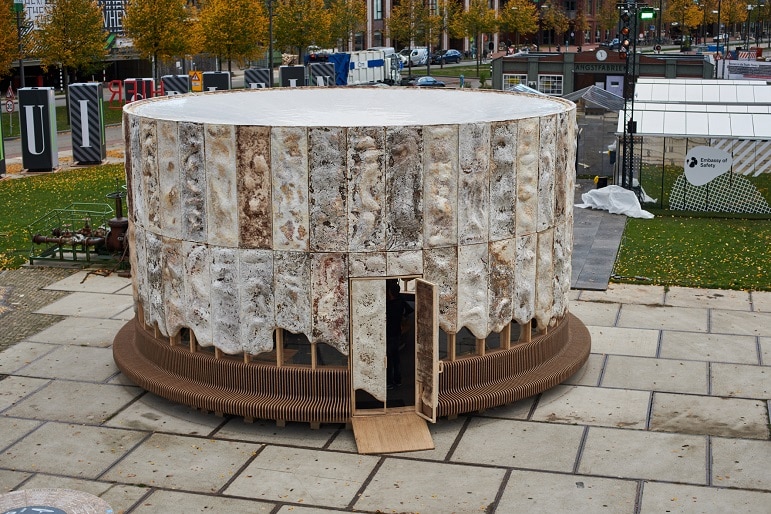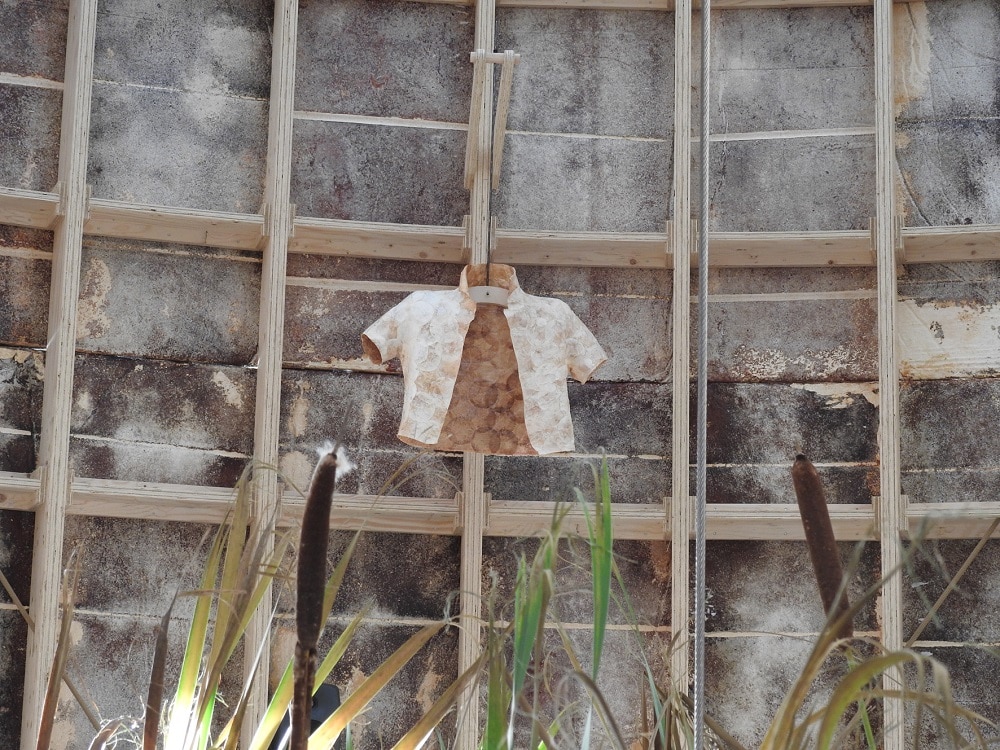As food fungi are renowned for their meaty, Unami flavor. In engineering, it’s equally beefy as part of sustainability. These fungi can do a lot more than we thought.
For the future
Nearly all industrially fabricated materials produced today, like construction and packaging materials, cannot be recycled and aren’t environmentally friendly.
The problem with this is that the world is running out of natural resources, and it’s a major factor in pollution.
Construction material has specifically come under the lens, due to urbanization – that needs more construction but also does it in ways that aren’t harmful.

The paper Mycelium-Based Composite: The Future Sustainable Biomaterial paints the correct picture.
The utilization of conventional materials consumes energy and pollutes water bodies and the natural environment during its manufacturing.
Even the decommission of old structures pollutes the environment and up to 10% of carbon dioxide emissions annually are released from the manufacturing of construction materials.
The answer seems to be in fungi, to counterbalance the sometimes-destructive force of construction in the modern world.
According to the paper, mycelium is the vegetative part of a fungus. This part has the mass of branching hyphae of the mushroom and a hollow, tubular structure that ensures a fast-growing, safe, and inert material as the binding matrix.
According to the paper, it is a natural binder that fastens onto organic substrates around it (including coffee husks, sawdust, straw and bagasse) and then creates a dense network of threads.
This leads to Mycelium-derived materials having low cost, low density, being eco-friendly, and less energy consumption.
As construction material
According to Mycelium-Based Composite: The Future Sustainable Biomaterial construction materials like blocks, partition walls and most importantly concrete is made out of combinations of cement, gypsum, sand, metal, and wood.
The paper estimates that 4.18 million tons of cement are produced every year just for one of these functions, and cement is crucial in the construction activities of the world.
Its compressive strength is coupled with its resistance to chemicals and weather conditions. Now the application of microorganisms in biomaterial production can change that.

How Mycelium can be used
Using mycelium started to get studied in 2007 as a non-toxic and recyclable alternative. Microbes can be applied in the construction sector by an indirect method where the production of construction materials uses enzymes extracted from microbes.
Alternatively, the direct method features the direct application of microbes such as in a cell wall, mycelium, and spore of microorganisms.
An enzyme extracted from microorganisms is used for soil stabilization. Some microbes also precipitate calcite from their cell wall and are used for calcium carbonate production.
As a result, in the direct method, Mycelium can be used in the production of bio concrete, bio blocks, bio cement, and lastly biopolymer (through precipitation of their calcium carbonate, secreting soil stabilizing enzyme, and through their unique natural adhesive property by their mycelium).
Since 2007 mycelium-based products have included synthetic leather, kitchen utensils, packaging, furniture, wall and ceiling panels and bio cement.
How it works
Mycelium has proven itself to be a worthy alternative thanks to the fact that it has a dense network of thin strands called hyphae that grow and fuse into a solid material.
Mycelium growth forms self-assembling bonds and miles of tiny white fibers which invade and degrade the organic substrate, gradually colonize the organic matter, and bind them into strong and 3D structure materials.
During the mycelium colonization, the cellulose or lignin or both compounds of the substrate can be degraded by fungi by secreting an enzyme such as lactase, lignin peroxidase (Lip), and manganese peroxidase, whereas hemicellulose is usually attacked by all the species. Not all species have the same lignin-degrading ability.
While degrading lingo cellulose substrate, the mycelium can assemble and form a block-like structure. This self-assembling property of mycelium makes fungi unique in the production of noble bioproducts.
As mycelium can grow easily on organic wastes, its derivative materials have the potential to become the material of choice for a wide variety of applications because they are emission-free, recyclable, and low-cost.

Is it effective?
Yes, some smaller structures are already scattered around the world.
But will it work as a construction material? The answer seems to be yes as well.
One of the world’s most famous Mycelium projects is The Growing Pavilion, an installation that proves the benefit of fungi in the built environment.
According to the press release from the project, social challenges such as climate change, subsidence, CO2 emissions and the scarcity of fossil fuels require new, sustainable solutions.
The call for a more biobased and circular economy is becoming increasingly necessary.
That is why Company New Heroes started the experiment of building a biobased pavilion, together with the Dutch design Foundation and other pioneers in the field.
The Growing Pavilion shows the possibilities and above all the outstanding beauty of biobased construction and design.
The uniqueness of the pavilion consists of the large number of biobased materials used- such as wood, hemp, mycelium, cattail and cotton, put together to form a building.
The Mycelium façade panels of the pavilion are a mixture of various natural resources. The main ingredient is traces of the Ganoderma Mushroom, also known as Reishi. When the mushroom is mixed with plant remains, mycelium is formed.
The mycelium used for The Growing Pavilion establishes a circular relationship with the agricultural and horticultural sectors in the Netherlands. Supplier Krown.bio uses ‘residual flows’ from farmers.
Residual flows are products that are left over at the end of a growing and processing process, such as stumps and branches.
A unique power of mycelium is that it can easily be moulded into any desired shape. The best way to do this is to fill moulds with it. These moulds can take various forms, from lampshades to chairs and facade panels. The moulds are covered so that there is only minimal oxygen supply and they are placed in a dark, closed room.
The moulds stay there for four to five days. The fungi spores start a slow process of breaking down the residual flows – you could say they eat them. The tracks create a natural network of connections through all plant remains.
This way they glue everything together. The moulds are then removed after a week in the humid environment and are baked at 80 degrees Celsius for two days.
The fungus growth process is stopped before the fungi sprout. This completes the production process and the mycelium designs are ready for use.

Fungi for building
There are many studies focused on the attempt to find new strains able to produce a strong and dense network of fungal filaments for construction purposes.
A manufacturing system of seven steps was elaborated to produce a sandwich structure of biocomposites made from agricultural waste and mushroom mycelium. In these matrix structures, the mycelium is acting as a “glue” for the whole mixture.
The biomaterial demonstrated many advantages over traditional synthetic composites, such as strength, tensile and impact mechanical properties, reduced energy consumption and biodegradability. The edible fungi Shiitake was used in the production of composites based on the mixture of polypropylene and sugarcane bagasse or in a mix of coconut powder with bran.
This has the benefit to valorize the residues from the coconut industry and reduce water and soil contamination.
A test conducted with Trametes Versicolor revealed that the mechanical performances of the mycelium-based composites depend more on the fiber condition, size, and processing than on the chemical composition.
The study evaluated many lignocellulosic substrates (hemp, flax, flax waste, softwood, straw), processed in different ways (loose, chopped, dust, pre-compressed and tow.
The second microorganism Bacillus amyloliquefaciens plays a role by improving the biocompatibility of thermoplastic materials intended for the formation, reinforcement, and increased durability of acoustic or thermal-insulating biomaterials obtained from the mycelium.
Bacillus amyloliquefaciens produce resistant spores protected through various mechanisms that ensure their survival for a long period, dormant periods, with little or no nutrients.
Whether the environment is changing and the amount of nutrients increases, the spores can return to life by germination.
References:
Alemu, D., Tafesse, M., & Mondal, A. K. (2022). Mycelium-Based Composite: The Future Sustainable Biomaterial. International Journal of Biomaterials, 2022, 1–12. https://doi.org/10.1155/2022/8401528
Răut, I., Călin, M., Vuluga, Z., Oancea, F., Paceagiu, J., Radu, N., … Jecu, L. (2021). Fungal-Based Biopolymer Composites for Construction Materials. Materials, 14(11), 2906. https://doi.org/10.3390/MA14112906
The Growing Pavillion, 2019. Materials Atlas. [online] Available at: https://thegrowingpavilion.com/material-atlas/


